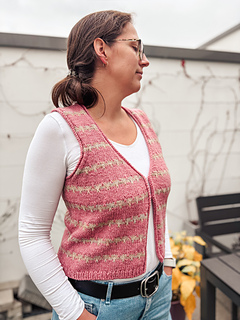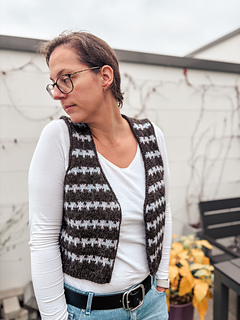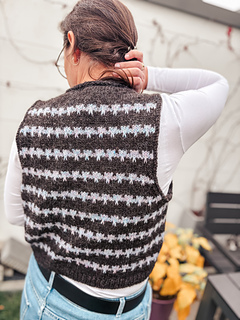patterns >  Carolin Balmes' Ravelry Store
Carolin Balmes' Ravelry Store
> Friedas MosaicVest









Friedas MosaicVest
Frieda’s MosaicVest is perfect for days when you need a light, warm layer. Whether for a walk, at the office, or cozying up at home. The optional striped pattern adds a subtle touch to the simple cut but can also be omitted. The result is a timeless knitwear piece that’s versatile and will last for years.
You begin with the back piece. After shaping the shoulders using short rows, work in rows until the increases for the armholes are complete. Then place the stitches on hold. Next, pick up stitches along the cast-on edge of the back piece to work the front pieces one at a time. Shape the neckline with increases, and work in rows until the armhole increases are complete. When all pieces are ready, join them together with the new cast on stitches and continue working the body in rows. Continue the neckline increases for a few more rows. The body of the vest is finished in rows. Finally, pick up stitches along the armhole edges and along the front bands of the vest to finish the edges neatly.
Optionally, you can sew on hooks or knit cords for tying.
Sizes
1 (2, 3, 4, 5) 6, 7, 8 (9, 10, 11, 12) with a bust circumference (finished garment) of: 79 / 31.1 (83/32.7, 87/34.3, 92/36.2, 96/37.8) 101/39.8, 105/41.3, 109/42.9 (114/44.9, 118/46.5, 123/48.4, 127/50) cm/in.
I recommend a positive ease of -2 to 5 cm.
Yarn
You need approx. 420 (440, 470, 490, 520) 540, 560, 580 (630, 660, 710, 750) m / 459.3 (482, 513, 536, 568) 590, 612, 635 (689, 722, 777, 820) yd “Aran-weight”-Garn (170-200 m / 186–220 yd = 100 g), e.g.:
- “Rh:ool Single” by Rh:ool Yarn (approx. 200 m / 220 yd = 100 g)
- “Folclore” by Rosarios 4 (approx. 190 m / 208 yd = 100 g)
- “Lettlopi” by Istex (approx. 200 m / 220 yd = 100 g)
Note: The yarn amounts refer to the given measurements and are calculated generously. If you knit the vest longer, keep in mind that you may need more yarn.
If you like to knit the mosaic-pattern, you will need approx.
300 (320, 350, 365, 390) 405, 420, 440 (470, 490, 535, 565) m / 328 (350, 383, 400, 426) 443, 460, 482 (513, 535, 585, 618) yds of the main color and approx. 100 (110, 120, 125, 130) 135, 140, 145 (160, 170, 180, 190) m / 110 (120, 131, 136, 142) 147, 153, 158 (175, 185, 197, 208) yds of the contrast color
Gauge
10 x 10 cm / 4 x 4 in = 18 sts x 28 rows in stockinette stitch with the larger needle.
Wash and let the swatch dry, before measuring it.
Other materials
- 4,0 and 4,5 mm / US6 and US7 circular needle or the needle size you need to achieve the specified gauge, possibly double-pointed needles in the same size for the armholes if you are not using the Magic Loop method
- stitch marker
- Scrap yarn for place stitches on hold
- Optional: hook-and-eye closure
- Tapestry needle for weaving in the ends
……………………………………………………………………………………………….
Friedas MosaicVest ist wie gemacht für Tage, an denen du eine leichte, wärmende Schicht brauchst. Ob beim Spaziergang, im Büro oder gemütlich zu Hause. Das optionale Streifenmuster verleiht dem schlichten Schnitt ein dezentes Extra, kann aber auch weggelassen werden. So entsteht ein zeitloses Strickstück, das sich vielseitig kombinieren lässt und lange Freude bereitet.
Du beginnst am Rückenteil. Nachdem du mit Hilfe von verkürzten Reihen die Schulter geformt hast, strickst du in Reihen, bis die Zunahmen für die Armausschnitte gestrickt sind. Dann legst du die Maschen still. Anschließend werden für die Vorderteile nacheinander Maschen entlang der Anschlagskante des Rückenteils aufgenommen. Der Halsausschnitt wird durch Zunahmen geformt. Auch hier strickst du, bis die Zunahmen für die Armausschnitte gestrickt sind. Wenn alle Teile fertig sind, verbindest du sie mit zusätzlich unter der Achsel angeschlagenen Maschen und strickst den Rumpf weiter in Reihen. Setze die Halsausschnittzunahmen noch einige Reihen fort. Der Körper der Weste wird in Reihen beendet.
Abschließend nimmst du entlang der Armausschnittöffnung und entlang der vorderen Blenden der Weste Maschen auf, um die Kanten zu versäubern.
Optional kannst du Haken annähen oder Bändel zum zubinden anstricken.
Größen
1 (2, 3, 4, 5) 6, 7, 8 (9, 10, 11, 12) mit einem Brustumfang (fertiges Kleidungsstück) von: 79 (83, 87, 92, 96) 101, 105, 109 (114, 118, 123, 127) cm.
Ich empfehle einen Bewegungsspielraum von -2 bis 5 cm.
Garn
Du brauchst ca.
420 (440, 470, 490, 520) 540, 560, 580 (630, 660, 710, 750) m “Aran-weight”-Garn (170-200 m = 100 g), z.B.:
- “Rh:ool Single” von Rh:ool Yarn (ca. 200 m = 100 g)
- “Folclore” von Rosarios 4 (ca. 190 m = 100 g)
- “Lettlopi” von Istex (ca. 200 m = 100 g)
Achtung: Der Verbrauch bezieht sich auf die angegebenen Maße. Strickst du die Weste länger, benötigst du ggf. mehr Garn.
Wenn du die gestreifte Variante strickst, benötigst du ca.
300 (320, 350, 365, 390) 405, 420, 440 (470, 490, 535, 565) m der Hauptfarbe, und ca. 100 (110, 120, 125, 130) 135, 140, 145 (160, 170, 180, 190) m der Kontrastfarbe
Maschenprobe
10 x 10 cm = 18 M x 28 R glatt rechts mit der größeren Nadel gestrickt.
Wasche und trockne die Maschenprobe, bevor du sie ausmisst.
Sonstige Materialien
- 4,0 und 4,5 mm Rundstricknadel bzw. die Nadelgröße, die du benötigst, um die angegebene Maschenprobe zu erreichen, ggf. Nadelspiel in der gleichen Größe, wenn du nicht die Magic-Loop-Methode verwendest
- 2 Maschenmarkierer
- Nadelhalter oder Garnreste zum Stilllegen von Maschen
- ggf. Haken zum verschließen
- Wollnadel zum Fäden vernähen
64258 projects
stashed
61269 times
5 projects
stashed
1 time
- First published: October 2025
- Page created: October 23, 2025
- Last updated: November 3, 2025 …
- visits in the last 24 hours
- visitors right now




